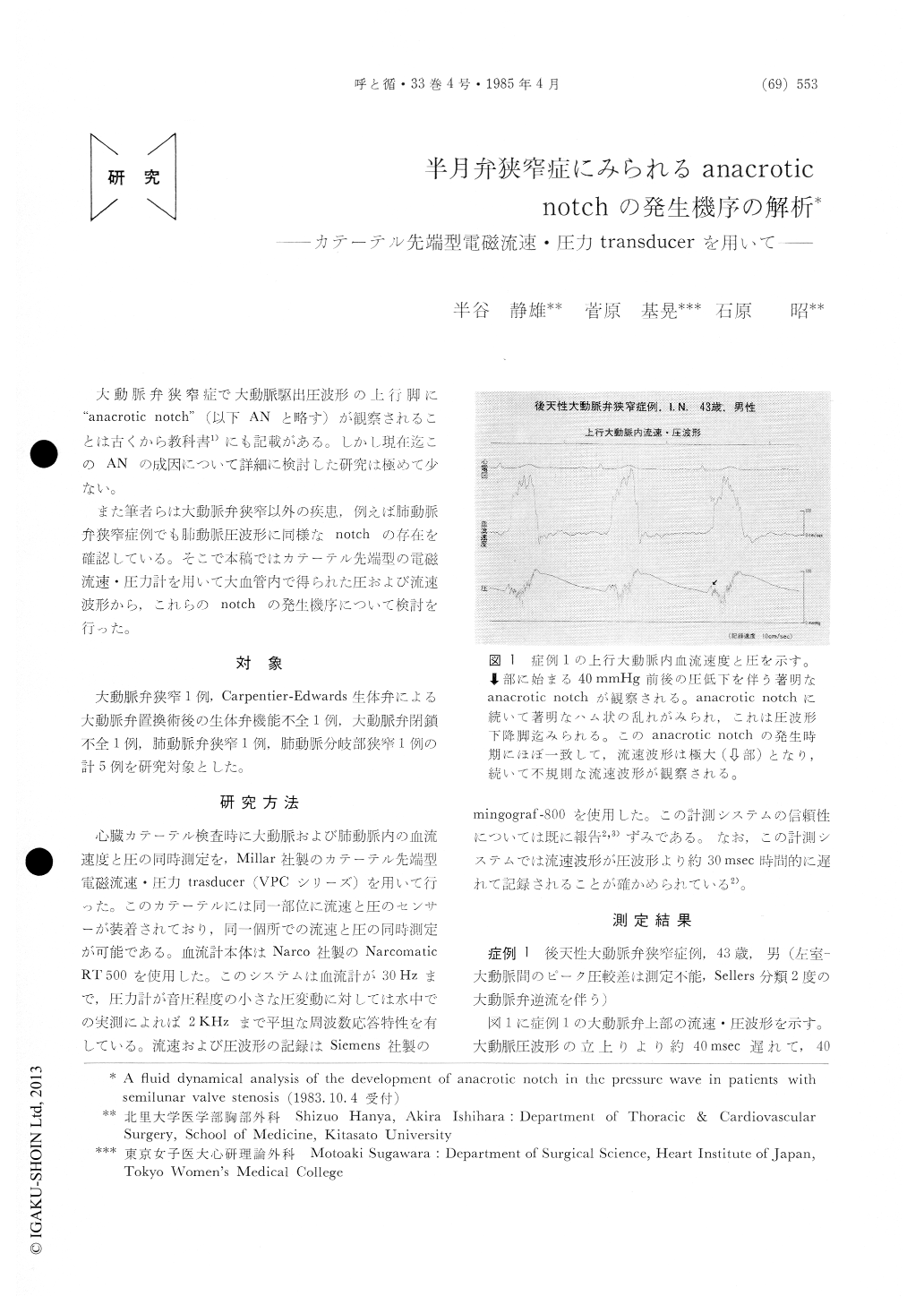Japanese
English
- 有料閲覧
- Abstract 文献概要
- 1ページ目 Look Inside
大動脈弁狭窄症で大動脈駆出圧波形の上行脚に"anacrotic notch"(以下ANと略す)が観察されることは古くから教科書1)にも記載がある。しかし現在迄このANの成因について詳細に検討した研究は極めて少ない。
また筆者らは大動振弁狭窄以外の疾患,例えば肺動脈弁狭窄症例でも肺動脈圧波形に同様なnotchの存在を確認している。そこで本稿ではカテーテル先端型の電磁流速・圧力計を用いて大血管内で得られた圧および流速波形から,これらのnotchの発生機序について検討を行った。
The purpose of this study is to make clear the mechanism responsible for the development of anacrotic notch (AN) in pressure tracings from the great arteries. One patient with aortic valvular stenosis, one with pulmonary valvular stenosis, one with a Hancock prosthetic aortic valve, one with aortic regurgitation and a patient with peri-pheral pulmonary stenosis were studied. Using a catheter tip velocity-pressure transducer, simulta-neous measurements of pressure and velocity were made in the aorta and the pulmonary artery. The pressure measuring system has a frequency response that is flat to beyond 2kHz in water, which makes it possible to detect pressure fluctuations in the turbulent flow in living subjects. The flowmeter was operated at a nominal frequency setting (30Hz).
A distinct anacrotic notch was observed in the aortic or pulmonary artery pressure tracings in all patients. The AN was initiated first by a sudden pressure drop which was succeeded by pressure fluctuations of different degrees of amplitude. These fluctuations persisted until the downstroke of the systolic pressure wave. The amplitude of the pressure fluctuations first increased during the rising phase of the systolic pressure wave and thenbegan to decrease or disappeared when the systolic pressure wave reached its peak. The AN (pressure drop) was always coincident with sudden changes in the contour of the velocity curve. The fluctua-tions in the velocity wave always appeared at the same time and were of the same duration as the pressure fluctuations. The cause of this sudden pressure drop (AN) can be explained in terms of fluid mechanics related to the above observations. It is well known in the field of fluid dynamics that the resistance to the flow increases when the lami-nar flow becomes turbulent. So if the flow rate is constant, transition from laminar to turbulent flow results in a pressure loss. In other words, a decrease in pressure can result from the dissipation of kinetic energy due to the development of turbulence. The breakdown of laminar flow into turbulence can easily occur in the presence of any type of obstruc-tion. Furthermore, other hemodynamic factors also contribute to the development of turbulence, of which the most prominent is blood velocity. Tur-bulence would develop in the presence of a nor-mal semilunar valve, if the velocity were high enough to exceed the critical Reynolds number.
The results of this study indicate that turbulent flow, whether in the aorta or pulmonary artery, initiates a pressure drop (AN) followed by pres-sure fluctuations. Furthermore it should be empha-sized that AN is not only characteristic of patients with semilunar valve stenosis or any other type of obstruction to flow but it is also seen in normal subjects in whom high peak velocity exceeding the critical Reynolds number would result in the de-velopment of turbulence.

Copyright © 1985, Igaku-Shoin Ltd. All rights reserved.


